Lizhi Lei
INarIG: Iterative Non-autoregressive Instruct Generation Model For Word-Level Auto Completion
Nov 30, 2023Abstract:Computer-aided translation (CAT) aims to enhance human translation efficiency and is still important in scenarios where machine translation cannot meet quality requirements. One fundamental task within this field is Word-Level Auto Completion (WLAC). WLAC predicts a target word given a source sentence, translation context, and a human typed character sequence. Previous works either employ word classification models to exploit contextual information from both sides of the target word or directly disregarded the dependencies from the right-side context. Furthermore, the key information, i.e. human typed sequences, is only used as prefix constraints in the decoding module. In this paper, we propose the INarIG (Iterative Non-autoregressive Instruct Generation) model, which constructs the human typed sequence into Instruction Unit and employs iterative decoding with subwords to fully utilize input information given in the task. Our model is more competent in dealing with low-frequency words (core scenario of this task), and achieves state-of-the-art results on the WMT22 and benchmark datasets, with a maximum increase of over 10% prediction accuracy.
Joint-training on Symbiosis Networks for Deep Nueral Machine Translation models
Dec 22, 2021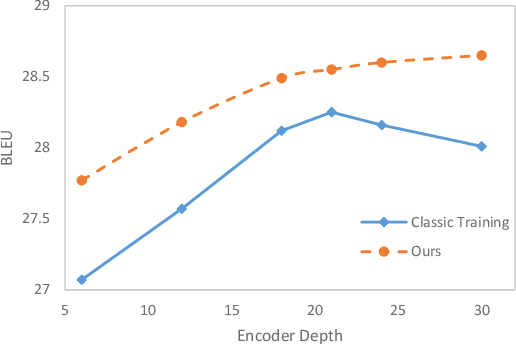
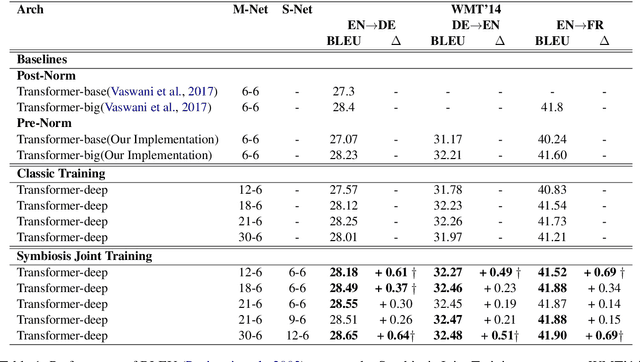
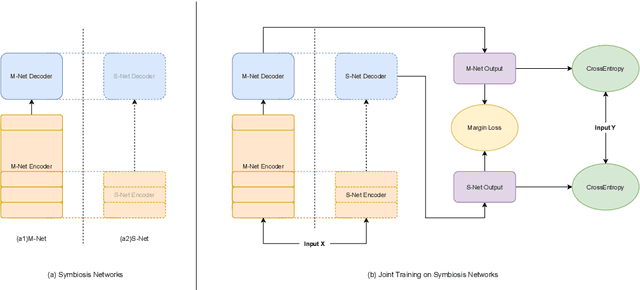
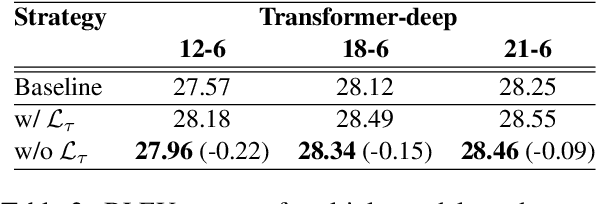
Abstract:Deep encoders have been proven to be effective in improving neural machine translation (NMT) systems, but it reaches the upper bound of translation quality when the number of encoder layers exceeds 18. Worse still, deeper networks consume a lot of memory, making it impossible to train efficiently. In this paper, we present Symbiosis Networks, which include a full network as the Symbiosis Main Network (M-Net) and another shared sub-network with the same structure but less layers as the Symbiotic Sub Network (S-Net). We adopt Symbiosis Networks on Transformer-deep (m-n) architecture and define a particular regularization loss $\mathcal{L}_{\tau}$ between the M-Net and S-Net in NMT. We apply joint-training on the Symbiosis Networks and aim to improve the M-Net performance. Our proposed training strategy improves Transformer-deep (12-6) by 0.61, 0.49 and 0.69 BLEU over the baselines under classic training on WMT'14 EN->DE, DE->EN and EN->FR tasks. Furthermore, our Transformer-deep (12-6) even outperforms classic Transformer-deep (18-6).
Self-Distillation Mixup Training for Non-autoregressive Neural Machine Translation
Dec 22, 2021


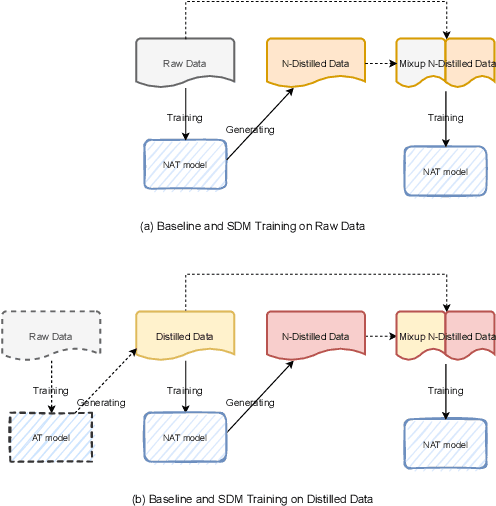
Abstract:Recently, non-autoregressive (NAT) models predict outputs in parallel, achieving substantial improvements in generation speed compared to autoregressive (AT) models. While performing worse on raw data, most NAT models are trained as student models on distilled data generated by AT teacher models, which is known as sequence-level Knowledge Distillation. An effective training strategy to improve the performance of AT models is Self-Distillation Mixup (SDM) Training, which pre-trains a model on raw data, generates distilled data by the pre-trained model itself and finally re-trains a model on the combination of raw data and distilled data. In this work, we aim to view SDM for NAT models, but find directly adopting SDM to NAT models gains no improvements in terms of translation quality. Through careful analysis, we observe the invalidation is correlated to Modeling Diversity and Confirmation Bias between the AT teacher model and the NAT student models. Based on these findings, we propose an enhanced strategy named SDMRT by adding two stages to classic SDM: one is Pre-Rerank on self-distilled data, the other is Fine-Tune on Filtered teacher-distilled data. Our results outperform baselines by 0.6 to 1.2 BLEU on multiple NAT models. As another bonus, for Iterative Refinement NAT models, our methods can outperform baselines within half iteration number, which means 2X acceleration.
 Add to Chrome
Add to Chrome Add to Firefox
Add to Firefox Add to Edge
Add to Edge